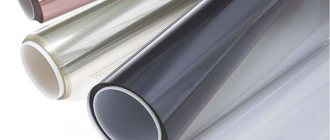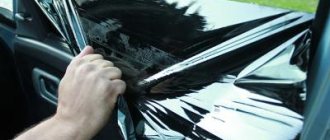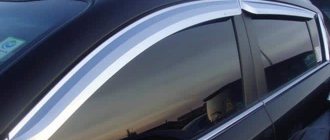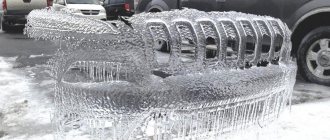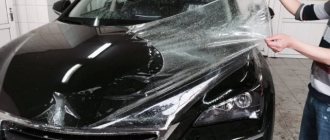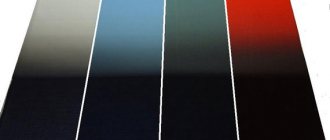Acceptable car tinting standards in 2021
According to GOST standards permitted for use, it is allowed to darken the windshield with a light transmittance of at least 75%. For front side windows this percentage can be reduced to 70%. The width of the darkened strip on the front glass should be no more than 14 centimeters from the top edge. Mirror type of car window tinting is prohibited. There are no restrictions regarding rear windows. It all depends on the desires and fantasies of the owner. If the permissible norms are violated, the driver may face a fine of 500 rubles.
What functions does window tinting perform? For what purpose do drivers tint their cars? Here are some reasons why vehicle owners do this:
- The interior of the car is closed from view; it is not visible from the outside whether there are passengers there or what objects are inside. At the same time, the driver himself, as well as everyone in the car, perfectly sees everything that happens outside the car.
- Tinting is a tuning method without making design changes. The car looks more noticeable and respectable; we can say that it is an element of decoration.
- The coating protects the car interior from heating and fading of the upholstery in summer and hot weather.
- Reflects the sun's rays, preventing the driver from being blinded.
- Protects passengers during an accident from small glass fragments, since the durable film does not allow it to fly apart in different directions.
- Prevents the formation of chips and cracks on the windshield if a pebble hits while the car is moving.
Types of tinting, subtleties of choosing a suitable film
Several types of tint are available. A more advanced and reliable option is the sprayed type . This technology is called magnetron or plasma. This type of darkening is quite complex and is not recommended for use at home. It is better to tint the glass using this method in the factory, thus achieving durability and resistance to damage.
Electronic tinting is only suitable for expensive cars; it is not installed on budget and middle-class models due to its inexpediency. Here special glasses are used, inside of which there is a light filtering element.
A more common option is tint film that is glued to the glass.
There are many products available that differ in characteristics, cost, popularity, and durability. This material is suitable for doing tinting yourself and can be easily dismantled if necessary.
When thinking about which film to choose for car window tinting, you should decide on the manufacturer, quality and type of raw materials.
Criteria requiring attention:
- Manufacturer's choice - American and German films are considered the best. Chinese brands are characterized by minimal cost, but also worse properties. The products of Solamatrix, SunTek, Sun-Gard are attractive due to their optimal cost and quality. If you want to choose the best option, you should study the reviews.
- Quality is confirmed by special certificates that determine the product’s compliance with established GOST standards. This indicator is important if tinting will be done independently. When contacting specialists, the responsibility lies with the service.
- The choice of film type is determined by the goals set. Impact-resistant, anti-vandal, and other protective options with different light transmittance are presented.
Attention:
Light transmittance is an equally important criterion. You should not choose options that are too dark, as the quality of visibility and safety are reduced, and the likelihood of receiving a fine cannot be ruled out.
Main types of films and their properties:
- Painted - this type has a minimal cost, but quickly loses its attractive appearance and may require replacement after a year;
- Metallized - attract greater durability, consist of several layers, where the inner one is made in the form of a metal coating (advantages - protection from ultraviolet radiation, radio waves, reflection of sunlight);
- Spatter - this tinting material is an improved type of metallized models, but here the metal is introduced at the molecular level, which guarantees better performance;
- Mirrored - perfectly reflects sunlight, very attractive, but prohibited as it reduces safety;
- Tinting with color transition - this type of film includes the properties of dyed and metallized, creating an interesting play of shades;
- Athermal - provide better protection against glare, contribute to less heating of the interior during hot periods;
- Carbon fiber is the most expensive option, rarely used, but allows you to get excellent protection from glare (the films practically do not wear out and do not fade);
- Removable – available in silicone and gel (the former are more cloudy and do not tolerate re-sticking well).
The cost of the material often determines quality and durability. The cheapest film does not adhere well, breaks, wears out quickly, does not protect from the sun, and will not last long. It is advisable to use it only as a temporary solution while looking for the best option for tinting.
We recommend crystal protection for your car.
Types of tints
Some manufacturers produce cars with factory-tinted windshields. This is done in two ways: by adding tinting pigment to the glass melt before casting the glass; by pyrolysis, when a thin layer of metal coating is applied to glass that has not yet cooled down under vacuum conditions. There are several options for tinting car windows:
- Spraying is a technologically complex process, carried out only under certain conditions, using special equipment.
- Electronic (smart glass) - a whole system, the dimming level is controlled using a remote control. Complex installation and dismantling, as well as the high cost of the system, do not allow it to become widespread.
- Tinting with adhesive film - the most common method of darkening offers a large selection:
- Tinted films are a budget-friendly way to change the color of glass, but the quality is well worth the price. They fade quickly and last no more than two years.
- Metallized: more durable, consist of three layers: the first is protective, the second is tinted, the third is coated with metal. This coating reflects the sun's rays well, but can interfere with mobile communications.
- Art tinting is the application of a pattern to a film, used primarily for rear windows.
- Athermal: manufactured by magnetron sputtering, have good light transmittance, and perform their functions well. They can be completely transparent, and the so-called chameleon, different shades with iridescence of purple, blue or green.
- Removable: silicone or gel based, attached to the inner surface of the glass due to its electrostatic properties. Allows you to repeatedly stick and peel them off, if necessary.
What types of films are there?
An important point is the choice of material for tinting car windows. There are several varieties that you can easily find in stores.
- Removable. A temporary option, easy to install and easy to remove.
- Painted. Cheap but short-lived film.
- Three-layer metallized. A layer of metal sputtering is applied between two layers of polymer. It lasts a long time and looks quite decent.
- Sputters. This is a two-layer metallized film. A metal coating is applied to the polymer layer, which is embedded into the base under pressure. Durable and reliable option.
- Carbon. Has graphite coating. It is distinguished by its matte shade and high cost.
- Athermal film. Can be any of the listed types, the main feature is a high level of heat ray retention. This helps keep the cabin cool.
Tinting also differs in the degree of light transmission. This parameter is indicated as a percentage, the film is marked like this “tinting 70”, this indicates that such a material transmits 70% of visible light.
Which glass tinting method to choose?
To make the right choice of material and method by which you want to tint your car, you need to evaluate your financial capabilities and weigh how much you are willing to pay for it. If preference is given to films, the main thing to consider is the light transmittance of the windshield and side front windows. Here, in order to avoid problems with the traffic police, it is better to comply with existing standards. You should not save money by choosing the cheapest option, because the effect will be short-lived and the quality is questionable. Choose films from manufacturers recognized as the best in this segment:
- LLUMAR.
- SUNTEK.
- ARMOLAN.
- SUNCONTROL.
- GLOBAL.
- JOHNSON.
- CONTRAST.
- MARTINSVILLE.
American companies have gained recognition among Russian car owners, and most drivers prefer them. As for color, it all depends on the preferences of the owner.
Acceptable characteristics
To avoid getting fined for tinting your car, you need to choose it correctly. First of all, we are talking about the degree of transparency. According to GOST 33997-2016, only tinting of the front glass is regulated. Any tint can be used on other windows.
For the windshield, the transparency of the tint must be at least 70%. If the light transmittance is lower, you will receive a penalty. Otherwise, you can use almost all types of film that are not prohibited.
But it’s worth talking about prohibited options separately. You cannot use mirror tints on your car. This is stated in the technical regulations. This type also includes chameleon film. Such tints can reflect headlights and blind drivers on the road.
Do not use green and blue colored films. It is not known why experts are unhappy with this tinting, but GOST has a restriction on its use.
How and where to tint car windows
- Of course, you can try to apply the tint film to the windows yourself. But to do this, you need to be sure that you can do it competently and efficiently. Otherwise it will be money thrown away. You must understand that installation may require removing the upholstery and seals from the car door, as well as the following tools:
- putty knife,
- spray,
- shampoo,
- rag,
- stationery knife,
- construction hairdryer
A special solution may be required to remove the tint film. It would be better to entrust the procedure to specialists whose experience has earned the trust of car enthusiasts. Auto center technicians have knowledge of technology and the necessary tools that contribute to high-quality work. In addition, auto repair shops give a guarantee on the work performed, if anything happens, there will be someone to ask. Autocenter “Marshal” will help you choose the best certified option for tuning your car. Will carry out work in accordance with the requirements and standards of GOST. Our prices for services are among the best in St. Petersburg, you will like the result. To order a service or ask a question, call and agree on a time convenient for you.
Main aspects
Tinting itself is initially one of the types of tuning, suggesting a partial change in the transparency of car windows and even their coloring.
Most often, the tinting procedure means darkening windows, but this is not always true, since there are colored types of tinting and even transparent ones, which provide greater protection for the glass.
The popularity of tinting also lies in the fact that for its installation it is not necessary to contact experts, since you can perform this simple procedure with your own hands.
But at the same time, the use of tinting is limited because the legislation has clear rules regarding this.
If the inspector detects low light transmittance and proves this with the device, the driver will be considered a violator and a report will be drawn up against him.
To measure the level of light transmission through glass, measurements should be taken in good weather, when there is no high humidity or rain.
In addition, the device must have seals, and certificates and certificates of compliance with standards must be supplied with it.
Before taking measurements, the inspector must calibrate the device and wipe the glass on both sides to ensure accurate data.
Initial data
The tinting itself is limited in the degree of darkness only on the windshield and front side windows; all other areas can be tinted at least 100 percent.
But regarding mirror tinting, the legislation is categorical - this type of film on glass is prohibited, as it poses a potential danger to road users.
And if in the case of tinting the inspector must first measure its light transmittance, then mirror tinting does not require this, since it is visible to the naked eye.
When a police officer claims that tinting is completely prohibited, he is breaking the law and interpreting it incorrectly.
After all, the regulations say that tinting itself is not an obstacle to driving, and only the level of darkness it creates on the windows plays a role.
At the same time, the type of tinting does not matter, because different types provide the same effect, darkening the light that enters the interior.
You also need to understand that tinting is installed on cars for several reasons, which mainly relate to comfort.
Among them:
- a layer of film protects the driver from the sun, as well as glare from its rays;
- the interior heats up less and burns out, since less sun passes into it;
- darkening prevents strangers and thieves from looking into the interior;
- savings on air conditioning, since in the hot season it is required less often;
- the car acquires a changed appearance without much effort from the owner.
Standards for light transmittance
In the legislation of the Russian Federation, the standards regarding the light transmittance of automobile glass are extremely strictly specified.
This mainly concerns the windshield and front side windows, which provide visibility to the driver.
If visibility in them is poor, then a motorist can create an emergency situation without noticing an obstacle or object at night.
Therefore, GOST states that the light transmittance of the above glasses should be no less than 70%.
When basing this value on, it should be noted that glass, even factory-made transparent glass, does not have 100% light transmittance either.
Therefore, if you take a film with a shading of 30% with 95% transmittance of the base glass, then this option will still violate the rules and will serve as a reason for a fine.
The driver cannot be forced to remove the tint on the spot, since he cannot have such skills.
In this case, an order is issued to eliminate the violation, which must be completed within a specified period.
What regulations governs
First of all, you should understand that there is no specific list of permitted tinting, and all legal requirements are related only to light transmittance.
GOST 32565-2013, which came into force in 2015, slightly changed the previous legislation. Moreover, changes that were pleasant for drivers happened right then.
They touched upon the level of possible tinting of the windshield, which before was only 25%, and with the new GOST, the permissible light transmittance became 70%, that is, tinting is permissible at 30%.
The side front mirrors were not affected by the changes; the level of required cross-country ability remained 70%.
When an inspector identifies a violation, he is obliged to stop it, and in the case of tinting, this means issuing a fine.
The order is not mandatory, but it is a completely legal document that obliges the car owner to take measures to remove the film or install new glass.
He does this under Article 12.5 of the Code of Administrative Offenses of the Russian Federation, which states what fine is charged for tinting and under what circumstances this happens.
